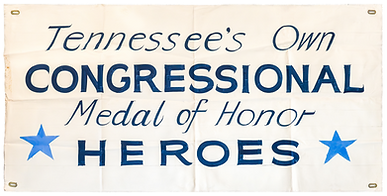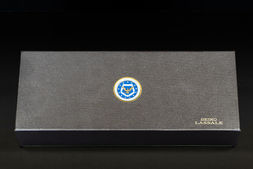





Physical artifacts

This archive brings together a collection of personal items owned and used by Medal of Honor recipient Charles H. Coolidge—artifacts that help tell the story of his service, character, and lifelong commitment to honoring America’s veterans. Among the highlights are some items used or obtained during his wartime service, a painting that was given to his mother by Colonel Charles Owens (141st regimental commander) in 1945, his Congressional Medal of Honor Society ring and watch, several of his Medal of Honor license plates, and a rare parade banner used during the American Legion parade in Memphis, TN in 1947. Each piece offers a tangible connection to Coolidge’s legacy and provides visitors with a deeper appreciation of the man behind the Medal.

NAPLES RING & BRACELET (1944)
During World War II, it was common for American servicemen stationed throughout the European Theater—especially in places like Italy, North Africa, and France—to acquire locally made souvenir jewelry as personal mementos. In cities such as Naples, which became a major Allied hub in 1943, local craftsmen produced rings, bracelets, pendants, and other small keepsakes that soldiers could purchase or have custom-made during periods of rest and recovery. These items were usually crafted from readily available materials, including aluminum from downed aircraft, coins, shell casings, and other wartime metal scraps, giving them a unique blend of artistry and battlefield resourcefulness.
Some pieces were simple tokens bearing local imagery, while others were intricately engraved with names, dates, unit insignia, or messages for loved ones back home. Because these objects were both deeply personal and highly portable, they became cherished reminders of service, friendship, and survival. Today, these handmade souvenirs are considered meaningful historical artifacts—reflecting not only the wartime experience but also the cultural exchanges that occurred far from the battlefield, in moments when soldiers sought identity, comfort, and connection amid uncertainty.
Below you will see two such souvenir items that were found in the bottom of a box while cleaning out Charles' house after his passing. It is presumed that he acquired these items in the same manner as other service members, and in fact, if you look closely at the photos taken of him in Naples in 1944, posing next to the Monumento a Domenico Martuscelli, you will see he is wearing a ring and a bracelet, so it is a logical assumption that they are one in the same.

PAINTING by POvilas (Paul) Puzinas (1945)



Before Charles left the European Theater, Colonel Charles Owens, his regimental commander, commissioned a painting by famed Lithuanian painter Povilas (Paul) Puzinas. He had Charles sit for some reference photos (see below) and when the painting was complete, he shipped it to Signal Mountain as a gift for Grace Coolidge (Charles' mother). It arrived in time for Christmas as you can see it hanging over the piano next to their Christmas tree on the occasion of Charles' first Christmas home after returning from the front lines.
About Povilas Puzinas:
Povilas (“Paul”) Puzinas (born August 3, 1907, in Riga, Latvia) was a painter and art teacher known for his evocative landscapes, still lifes, portraits and thematic works that reflect his biographical experience of war, exile, and nostalgia. He studied at the Latvian Academy of Art under landscape painter Vilhelms Purvītis, and by the late 1930s had settled in Lithuania, teaching drawing at a boys’ high school in Panevėžys and creating murals for the Panevėžys Cathedral. During World War II, he lectured at the Kaunas Institute of Applied and Decorative Arts (roughly 1940–1943). During the German occupation, he was involved in resistance activities with the Lithuanian Underground. In 1944 he was arrested, imprisoned in Riga, and later fled to Germany where he survived in displaced-persons camps. His camp was liberated by the 36th Infantry Division in 1945. In 1947 he emigrated to the United States, where he taught in New York and Long Island, ran a private art studio, and contributed as art editor to the Lithuanian diaspora publication Lietuvių dienos until his death from a heart attack on October 23, 1967.

American LEGION Parade Banner
Memphis, TN - July 22, 1947



The hand-painted parade banner shown above was displayed on the side of the jeep carrying Charles Coolidge and his wife, Frances, during the American Legion Parade in Memphis on July 22, 1947. Remarkably well-preserved for its age, it stands as a rare surviving example of a 1940s parade banner, as most were discarded after the event. A photograph of the banner on the side of the jeep during the parade can be seen above, along with a newspaper article from the Memphis Press-Scimitar published the following day highlighting the Medal of Honor recipients who took part in the parade.

Congressional Medal of Honor Society
Ring & Watch
Two more very personal pieces that belonged to Charles Coolidge were his Congressional Medal of Honor Society Ring and his watch. These meaningful personal artifacts reflect his decades of involvement with the Society and stand as enduring reminders of his service, character, and connection to fellow Medal of Honor recipients. He wore the watch every day, and that is evident by the wear seen on it.

Medal of Honor License Plates
Several U.S. states issue special license plates exclusively for Medal of Honor recipients, offering both recognition and, in some cases, additional benefits. Eligibility is typically limited to living recipients, and applicants must verify their award; some states also extend eligibility to spouses. Certain states provide these plates at no cost, such as New York, which waives registration and service fees, while Georgia allows recipients to receive two personalized plates free of charge. Design varies by state, but often includes inscriptions such as “Congressional Medal of Honor” or “Medal of Honor,” along with Medal imagery or symbolic elements. Some states also include special privileges—for example, Washington permits up to three sets of plates, and Nevada may exempt holders from parking meter fees when combined with disability designation. Because Medal of Honor recipients are very few in number, these plates are rare and often hold historical, symbolic, and collectible value, especially older or discontinued designs. Below are just two examples of some of the Medal of Honor license plates that Charles Coolidge owned, as well as some photos showing the plates on his vehicle.


_trans_2.png)

-2.png)
Desmond Doss and Charles Coolidge pose with their Medal of Honor license plates - Chattanooga, TN, 1985.
Medal of Honor Flag
The Medal of Honor Flag is a distinctive light-blue flag featuring 13 white stars arranged in the shape of the Medal of Honor’s star, symbolizing the nation’s highest military decoration for valor. Authorized by Congress in 2001 and formally unveiled in 2003, the flag serves as a national emblem of gratitude for extraordinary heroism. When flown or displayed at the funeral of a Medal of Honor recipient, it represents the country’s deep respect for the individual's sacrifice, courage, and service far above the call of duty. Its presence is a solemn reminder that the recipient performed actions of such gallantry that they earned a place among the most honored figures in American military history.
The flag seen below was flown at the funeral (graveside service) of Charles Coolidge on April 16, 2021. It was then presented to his son, Charles Coolidge, Jr. to acknowledge his father's duty to the nation and the exceptional heroism that merited the Medal of Honor itself.


_edite.png)




























